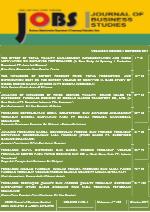THE INFLUENCE OF CONTAINER CRANE PRODUCTIVITY AND THE SHIP CALL FREQUENCY ON THE CARGO HANDLING PERFORMANCE
DOI:
https://doi.org/10.32497/jobs.v1i2.650Abstract
The purpose of this research are to analyze the influence of container crane productivity (X1)
and ship call frequency (X2) on the number of containers handled (Y) at Terminal Petikemas
Semarang branch PT. Pelabuhan Indonesia III. The tool of analysis which was used was
Multiple Regression with Classic Assumption Test. This research used secondary data obtained
from TPKS such as monthly report the achievement of performance, monthly report of ship call
and monthly report of stevedoring production within period of 6.5 years (January 2009 ”“ June
2015).The Result of the Multiple Regression Analysis was Log Y = 4.923991 + 0.525387 log XI
+ 0.423276 log X2 + e. This equation showed that all regression coefficients were positive. It
means that if container crane productivity and ship call frequency was increased, the number of
the containers handled would increase too.β
1
= 0.525, it means that if there is increase in
container crane productivity by 10%, it will increase the cargo handling performance by 5.25%.
Next, β
= 0.423, it explains that if there is an increase in ship call frequency by 10%, it will
increase the cargo handling performance by 4.23%. The result of Coefficient of Determination of
Test shows that container crane productivity and ship call frequency give the proportion or
percentage of the total variation in the number of containers handled for about 94,8%. While, FTest
shows that container crane productivity and ship call frequency influenced simultaneously
on the number of containers handled. Furthermore, container crane productivity influenced
positively on the number of containers handled. Then the other X variable, ship call frequency
influenced positively on the number of containers handled.
2
Key words: Container Crane, Ship Call, Cargo Handling and Port.
Downloads
Published
Issue
Section
License
Authors who publish with this journal agree to the following terms:
Authors retain copyright and grant the journal right of first publication with the work simultaneously licensed under a Creative Commons Attribution License that allows others to share the work with an acknowledgement of the work's authorship and initial publication in this journal.
Authors are able to enter into separate, additional contractual arrangements for the non-exclusive distribution of the journal's published version of the work (e.g., post it to an institutional repository or publish it in a book), with an acknowledgement of its initial publication in this journal.
Authors are permitted and encouraged to post their work online (e.g., in institutional repositories or on their website) prior to and during the submission process, as it can lead to productive exchanges, as well as earlier and greater citation of published work (See The Effect of Open Access).






